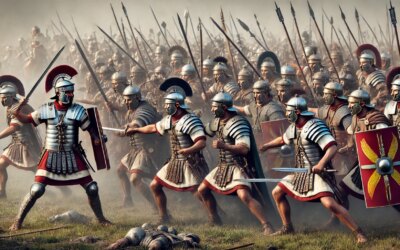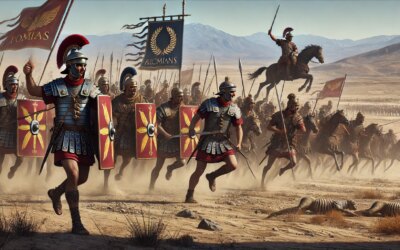Introduction: Greed, Glory, and Tragedy
In 53 BC, Marcus Licinius Crassus—wealthiest man in Rome and member of the First Triumvirate—marched east in pursuit of military glory and riches. His target was the Parthian Empire, Rome’s powerful rival in the Near East. What began as an ill-conceived campaign quickly spiraled into one of the Republic’s greatest military humiliations. At the Battle of Carrhae, Crassus’s legions were crushed, and the dream of eastern conquest died in the sands of Mesopotamia.
Crassus: The Ambitious Millionaire
Crassus was not a natural general. Known more for his vast fortune—accumulated through property speculation and political maneuvering—he had long lived in the shadow of Caesar’s victories in Gaul and Pompey’s Eastern conquests. Eager to secure a military triumph to rival his peers, he leveraged his position within the Triumvirate to obtain a special command in the East, despite the Senate’s opposition and public skepticism.
The Road to Parthia
In 54 BC, Crassus set out for Syria with seven legions, approximately 35,000 infantry and 4,000 cavalry, along with auxiliary forces. His campaign lacked both Senate authorization and a clear strategic objective. Rejecting offers of allied Armenian support and safer mountain routes, he chose to march his army directly into the open plains of Mesopotamia—ideal terrain for Parthian cavalry.
The Battle of Carrhae
On June 9, 53 BC, near the town of Carrhae (modern Harran, Turkey), Crassus met the forces of Parthian general Surena. Though outnumbered, the Parthians held the advantage in mobility and tactics. Their elite horse archers, supported by heavily armored cataphracts, harassed the Roman columns relentlessly. Roman formations faltered under constant arrow volleys and heat exhaustion. Crassus, unable to adapt to the mobile threat and lacking cavalry support, watched his legions wither and die.
The Death of Crassus
After a failed attempt to negotiate a retreat, Crassus was lured into a trap under the pretense of parley. He was killed in the ensuing melee—possibly by decapitation or molten gold, depending on the account. His severed head was later used in a theatrical performance at the Parthian court, symbolizing Rome’s humiliation and Parthia’s triumph.
The Aftermath: Shockwaves in Rome
The loss at Carrhae was catastrophic. Over 20,000 Romans were killed, and 10,000 were captured. The Parthians paraded Roman standards and prisoners across their empire. Politically, the disaster shattered the Triumvirate. Caesar and Pompey, now rivals without Crassus as a counterweight, drifted toward civil war. Militarily, Rome’s eastern ambitions were checked for a generation, and Carrhae remained a haunting memory for Roman strategists.
Legacy of the Defeat
Carrhae became a cautionary tale in Roman military lore. It illustrated the dangers of underestimating unfamiliar enemies, the perils of vanity-driven campaigns, and the critical importance of adaptable tactics. Crassus’s hubris cost Rome dearly—but it also forced a reevaluation of Rome’s limits and methods. In later centuries, generals like Trajan and Septimius Severus would tread more carefully in eastern campaigns.
Conclusion: Glory Denied
In 53 BC, Marcus Crassus sought a crown of military laurels to match his golden empire—but found only disaster. The sands of Carrhae swallowed not only his legions but his ambition. His story is a reminder that wealth cannot buy wisdom, and that empire, for all its grandeur, is built as much on discipline as on daring.






